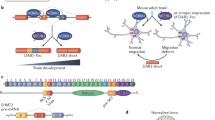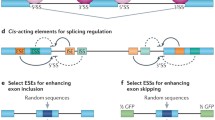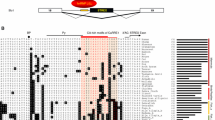Abstract
Alternative splicing is now recognized as a ubiquitous mechanism for controlling gene expression in a tissue-specific manner. A growing body of work from the past few years has begun to also highlight the existence of networks of signal-responsive alternative splicing in a variety of cell types. While the mechanisms by which signal transduction pathways influence the splicing machinery are relatively poorly understood, a few themes have begun to emerge for how extracellular stimuli can be communicated to specific RNA-bindingproteins that control splice site selection by the spliceosome. This chapter describes our current understanding of signal-induced alternative splicing with an emphasis on these emerging themes and the likely directions for future research.
Preview
Unable to display preview. Download preview PDF.
Similar content being viewed by others
References
Pinol-Roma S, Dreyfuss G. Shuttling of pre-mRNA binding proteins between nucleus and cytoplasm. Nature 1992; 355(6362):730–732.
Caceres JF, Screaton GR, Krainer AR. A specific subset of SR proteins shuttles continuously between the nucleus and the cytoplasm. Genes Dev 1998; 12(1):55–66.
Khokhlatchev AV, Canagarajah B, Wilsbacher J et al. Phosphorylation of the MAP kinase ERK2 promotes its homodimerization and nuclear translocation. Cell 1998; 93(4):605–615.
Bomsztyk K, Denisenko O, Ostrowski J. hnRNP K: one protein multiple processes. Bioessays 2004; 26(6):629–638.
Kim JH, Hahm B, Kim YK et al. Protein-protein interaction among hnRNPs shuttling between nucleus and cytoplasm. J Mol Biol 2000; 298(3):395–405.
Shnyreva M, Schullery DS, Suzuki H et al. Interaction of two multifunctional proteins. Heterogeneous nuclear ribonucleoprotein K and Y-box-binding protein. J Biol Chem 2000; 275(20):15498–15503.
Expert-Bezancon A, Le Caer JP, Marie J. Heterogeneous nuclear ribonudeoprotein (hnRNP) K is a component of an intronic splicing enhancer complex that activates the splicing of the alternative exon 6A from chicken bcta-tropomyosin pre-mRNA. J Biol Chem 2002; 277(19):16614–16623.
Ostrowski J, Kawata Y, Schullery DS et al. Insulin alters heterogeneous nuclear ribonucleoprotein K protein binding to DNA and RNA. Proc Natl Acad Sci USA 2001; 98(16):9044–9049.
Ostrowski J, Schullery DS, Denisenko ON et al. Role of tyrosine phosphorylation in the regulation of the interaction of heterogenous nuclear ribonudeoprotein K protein with its protein and RNA partners. J Biol Chem 2000; 275(5):3619–3628.
Lukong KE, Richard S. Sam68, the KH domain-containing superSTAR. Biochim Biophys Acta 2003; 1653(2):73–86.
Fumagalli S, Totty NF, Hsuan JJ et al. A target for Src in mitosis. Nature 1994; 368(6474):871–874.
Taylor SJ, Shalloway D. An RNA-binding protein associated with Src through its SH2 and SH3 domains in mitosis. Nature 1994; 368(6474):867–871.
Taylor SJ, Resnick RJ, Shalloway D. Sam68 exerts separable effects on cell cycle progression and apoptosis. BMC Cell Biol 2004; 5:5.
Najib S, Martin-Romero C, Gonzalez-Yanes C et al. Role of Sam68 as an adaptor protein in signal transduction. Cell Mol Life Sci 2005; 62(1):36–43.
Batschc E, Yaniv M, Muchardt C. The human SWI/SNF subunit Brm is a regulator of alternative splicing. Nat Struct Mol Biol 2006; 13(1):22–29.
Matter N, Herrlich P, Konig H. Signal-dependent regulation of splicing via phosphorylation of Sam68. Nature 2002; 420(6916):691–695.
Cheng C, Sharp PA. Regulation of CD44 Alternative Splicing by SRm160 and Its Potential Role in Tumor Cell Invasion. Mol Cell Biol 2006; 26(1):362–370.
Ponta H, Sherman L, Herrlich PA. CD44: from adhesion molecules to signalling regulators. Nat Rev Mol Cell Biol 2003; 4(1):33–45.
Konig H, Ponta H, Herrlich P. Coupling of signal transduction to alternative pre-mRNA splicing by a composite splice regulator. EMBO J 1998; 17:2904–2913.
Weg-Remers S, Ponta H, Herrlich P et al. Regulation of alternative pre-mRNA splicing by the ERK MAP-kinase pathway. EMBO J 2001; 20(15):4194–4203.
Stoss O, Olbrich M, Hartmann AM et al The STAR/GSG family protein rSLM-2 regulates the selection of alternative splice sites. J Biol Chem 2001; 276(12):8665–8673.
Xiao SH, Manley JL. Phosphorylation of the ASF/SF2 RS domain affects both protein-protein and protein-RNA interactions and is necessary for splicing. Genes Dev 1997; 11(3):334–344.
Xiao SH, Manley JL. Phosphorylation-dephosphorylation differentially affects activities of splicing factor ASF/SF2. EMBO J 1998; 17(21):6359–6367.
Sanford JR, Ellis JD, Cazalla D et al. Reversible phosphorylation differentially affects nuclear and cytoplasmic functions of splicing factor 2/alternative sphcing factor. Proc Natl Acad Sci USA 2005; 102(42):15042–15047.
Graveley B. Sorting out the complexity of SR protein functions. RNA 2000; 6:1197–1211.
Cao W, Jamison SF, Garcia-Blanco MA. Both phosphorylation and dephosphorylarion of ASF/SF2 are required for pre-mRNA sphcing in vitro. RNA 1997; 3(12):1456–1467.
Misteli T, Caceres JF, Clement JQ et al. Serine phosphorylation of SR proteins is required for their recruitment to sites of transcription in vivo. J Cell Biol 1998; 143(2):297–307.
Huang Y, Yario TA, Steitz JA. A molecular link between SR protein dephosphorylation and mRNA export. Proc Natl Acad Sci USA 2004; 101(265):9666–9670.
Ngo JC, Chakrabarti S, Ding JH et al. Interplay between SRPK and Clk/Sty kinases in phosphorylation of the splicing factor ASF/SF2 is regulated by a docking motif in ASF/SF2. Mol Cell 2005; 20(1):77–89.
Colwill K, Feng LL, Yeakley JM et al. SRPK1 and Clk/Sty protein kinases show distinct substrate specificities for serine/arginine-rich splicing factors. J Biol Chem 1996; 271(40):24569–24575.
Colwill K, Pawson T, Andrews B et al. The Clk/Sty protein kinase phosphorylates SR splicing factors and regulates their intracellular distribution. EMBO J 1995; 15:265–275.
Labourier E, Rossi F, Gallouzi IE et al. Interaction between the N-terminal domain of human DNA topoisomerase I and the arginine-serine domain of its substrate determines phosphorylation of SF2/ASF splicing factor. Nucleic Acids Res 1998; 26(12):2955–2962.
Rossi F, Labourier E, Forne T et al. Specific phosphorylation of SR proteins by mammalian DNA topoisomerase I. Nature 1996; 381(6577):80–82.
Patel NA, Kaneko S, Apostolatos HS et al Molecular and genetic studies imply Ala-mediated signaling promotes protein kinase CbetaII alternative splicing via phosphorylation of serine/arginine-rich splicing factor SRp40. J Biol Chem 2005; 280(14):14302–14309.
Blaustein M, Fetisch F, Tanos T et al. Concerted regulation of nuclear and cytoplasmic activities of SR proteins by AKT. Nat Struct Mol Biol 2005; 12(12):1037–1044.
Misteli T, Spector DL. Serine/threonine phosphatase 1 modulates the subnuclear distribution of prc-mRNA spiking factors. Mol Biol Cell 1996; 7(10):1559–1572.
Mermoud JE, Cohen P, Lamond AL Ser/Thr-specific protein phosphatases are required for both catalytic steps of pre-mRNA spiking. Nucleic Acids Res 1992; 20(20):5263–5269.
Shi Y, Reddy B, Manley JL. PP1/PP2A phosphatases are required for the second step of Pre-mRNA splicing and target specific snRNP proteins. Mol Cell 2006; 23(6):819–829.
Krecic AM, Swanson MS. hnRNP complexes: composition, structure and function. Curr Opin Cell Biol Jun 1999; 11(3):363–371.
Vassileva MX, Matunis MJ. SUMO modification of heterogeneous nuclear ribonucleoproteins. Mol Cell Biol 2004; 24(9):3623–3632.
Kim SC, Sprung R, Chen Y et al. Substrate and functional diversity of lysine acetylation revealed by a proteomics survey. Mot Cell 2006; 23(4):607–618.
Bedford MX, Richard S. Arginine methylation an emerging regulator of protein function. Mol Cell 2005; 18(3):263–272.
Magistrelli G, Jeannin P, Herbault N et al. A soluble form of CTLA-4 generated by alternative sphcing is expressed by nonstimulated human T-cells. Eur J Immunol 1999; 29(11):3596–3602.
Mayrand SH, Dwen P, Pederson X Serine/threonine phosphorylation regulates binding of C hnRNP proteins to pre-mRNA. Proc Nad Acad Sci USA 1993; 90(16):7764–7768.
Guil S, Long JC, Caceres JF. hnRNP A1 relocalization to the stress granules reflects a role in the stress response. Mol Cell Biol 2006; 26(15):5744–5758.
Xie J, Lee JA, Kress TL et al. Protein kinase A phosphorylation modulates transport of the polypyrimidine tract-binding protein. Proc Nad Acad Sci USA 2003; 100(15):8776–8781.
Chalfant CE, Mischak H, Watson JE et al. Regulation of alternative splicing of protein kinase C beta by insulin. J Biol Chem 1995; 270(22):13326–13332
Cooper DR, Watson JE, Patel N et al. Ectopic expression of protein kinase CbetaII, delta and-epsilon, but not-betal or-zeta, provide for insulin stimulation of glucose uptake in NIH-3T3 cells. Arch Biochem Biophys 1999; 372(1):69–79.
Fuel NA, Chalfant CE, Watson JE et al. Insulin regulates alternative splicing of protein kinase C beta II through a phosphatidylinositol 3-kinase-dcpendent pathway involving the nuclear serine/arginine-rich splicing factor, SRp40, in skeletal muscle cells, J Biol Chcm 2001; 276(25):22648–22654.
Patel NA, Apostolatos HS, Mebert K et ai Insulin regulates protein kinase CbttaII alternative splicing in multiple target tissues: development of a hormonally responsive heterologous minigene. Mol Endocrinol 2004; 18(4):899–911.
Blaustein M, Pelisch F, Coso OA et al. Mammary epithelial-mesenchymal interaction regulates fibronectin alternative splicing via phosphatidylinositol 3-kinase. J Biol Chem 2004; 279(20):21029–21037.
Lamond AI, Spector DL. Nuclear speckles: a model for nuclear organdies. Nat Rev Mol Cell Biol 2003; 4(8):605–612.
Misteli T, Caceres JF, Spector DL. The dynamics of a pre-mRNA splicing factor in living cells. Nature 1997; 387(6632):523–527.
Moen Jr PT, Johnson CV, Byron M et al. Repositioning of muscle-specific genes relative to the periphery of SC-35 domains during skeletal myogenesis. Mol Biol Cell 2004; 15(1):197–206.
Shopland LS, Johnson CV, Byron M et al. Clustering of multiple specific genes and gene-rich R-bands around SC-35 domains: evidence for local euchromatic neighborhoods. J Cell Biol 2003; 162(6):981–990.
Shopland LS, Johnson CV, Lawrence JB. Evidence that all SC-35 domains contain mRNAs and that transcripts can be structurally constrained within these domains. J Struct Biol 2002; 140(1–3):131–139.
Mabon SA, Misteli T. Differential recruitment of pre-mRNA splicing factors to alternatively spliced transcripts in vivo. PLoS Biol 2005; 3(11):374e.
Ding JH, Zhong XY, Hagopian JC et al. Regulated cellular partitioning of SR protein-specific kinases in mammalian cells. Mol Biol Cell 2006; 17(2):876–885.
Gui JF, Lane WS, Fu X-D. A serine kinase regulates intracellular localization of splicing factors in the cell cycle. Nature 1994; 369:678–682.
Allemand E, Guil S, Myers M et al. Regulation of heterogenous nuclear ribonucleoprotein A1 transport by phosphorylation in cells stressed by osmotic shock, Proc Natl Acad Sci USA 2005; 102(10):3605–3610.
van der Houven van Oordt W, Diaz-Meco MT, Lozano J et al. The MKK(3/6)-p38-signaling cascade alters the subcellular distribution of hnRNP A1 and modulates alternative splicing regulation, J Cell Biol 2000; 149(2):307–316.
Eperon IC, Makarova OV, Mayeda A et al. Selection of alternative 5′ splice sites: role of Ul sn-RNP and models for the antagonistic effects of SF2/ASF and hnRNP A1. Mol Cell Biol 2000; 20(22):8303–8318.
Lee BJ, Cansizoglu AE, Suel KE et al. Rules for nuclear localization sequence recognition by karyopherin beta 2. Cell 2006; 126(3):543–558.
Chook YM, Blobel G. Karyopherins and nuclear import. Curr Opin Struct Biol 2001; 11(6):703–715.
Meissner M, Dechat T, Gemer C et al. Differential nuclear localization and nuclear matrix association of the splicing factors PSF and PTB. J Cell Biochem 2000; 76(4):559–566.
Rosonina E, Ip JY, Calarco JA et al. Role for PSF in mediating transcriptional activator-dependent stimulation of pre-mRNA processing in vivo. Mol Cell Biol 2005; 25(15):6734–6746.
Emili A, Shales M, McCracken S et al. Splicing and transcription-associated proteins PSF and p54nrb/ nonO bind to the RNA polymerase II CTD. RNA 2002; 8(9):1102–1111.
Shav-Tal Y, Zipori D. PSF and p54(nrb)/NonO—multi-functional nuclear proteins. FEBS Lett 2002; 531(2):109–114.
Rosenberger U, Lehmann L, Weise C et al. Identification of PSF as a protein kinase Calpha-binding protein in the cell nucleus. J Cell Biochem 2002; 86(23):394–402.
Shav-Tal Y, Cohen M, Lapter S et al. Nuclear relocalization of the pre-mRNA splicing factor PSF during apoptosis involves hyperphosphorylation, masking of antigenic epitopes and changes in protein interactions. Mol Biol Cell 2001; 12(8):2328–2340.
Gerondakis S, Grumont R, Rourke I et al. The regulation and roles of Rel/NF-kappa B transcription factors during lymphocyte activation. Curr Opin Immunol 1998; 10(3):353–359.
Guhaniyogi J, Brewer G. Regulation of mRNA stability in mammalian cells. Gene 2001; 265(l–2):11–23.
Metivier R, Reid G, Gannon F. Transcription in four dimensions: nuclear receptor-directed initiation of gene expression. EMBO Rep 2006; 7(2):161–167.
Schimmer BP, Cordova M, Cheng H et al. Global profiles of gene expression induced by adrenocorticotropin in Y1 mouse adrenal cells. Endocrinology 2006; 147(5):2357–2367.
Uematsu F, Takahashi M, Yoshida M et al. Distinct patterns of gene expression in hepatocellular carcinomas and adjacent noncancerous, cirrhotic liver tissues in rats fed a choline-deficient, L-amino acid-defined diet. Cancer Sci 2005; 96(7):414–424.
Screaton GR, Caceres JF, Mayeda A et al. Identification and characterization of three members of the human SR family of pre-mRNA splicing factors. EMBO J 1995; 14:4336–4349.
Hou VC, Lersch R, Gee SL et al. Decrease in huRNP A/B expression during erythropoiesis mediates a pre-mRNA splicing switch. EMBO J 2002; 21(22):6195–6204.
Kornblihtt AR. Chromatin, transcript elongation and alternative splicing. Nat Struct Mol Biol 2006; 13(1):5–7.
Kornblihtt AR, de la Mata M, Fededa JP et al. Multiple links between transcription and splicing. RNA 2004; 10(103):1489–1498.
Bentley DL. Rules of engagement: cotranscriptional recruitment of pre-mRNA processing factors. Curt Opin Cell Biol 2005; 17(3):251–256.
Maniatis T, Reed R. An extensive network of coupling among gene expression machines. Nature 2002; 416(6880):499–506.
Cramer P, Caceres JF, Cazalla D et al. Coupling of transcription with alternative splicing: RNA pol II promoters modulate SF2/ASF and 9G8 effects on an exonic splicing enhancer. Mol Cell 1999; 4(2):251–258.
West MJ, Lowe AD, Kam J. Activation of human immunodeficiency virus transcription in T-cells revisited: NF-kappaB p65 stimulates transcriptional elongation. J Virol 2001; 75(18):8524–8537.
Lonard DM, O’Malley BW. Expanding functional diversity of the coactivators. Trends Biochem Sci 2005; 30(3):126–132.
Aubocuf D, Honig A, Berget SM et al. Coordinate regulation of transcription and splicing by steroid receptor coregulators. Science 2002; 298(5592):416–419.
Auboeuf D, Dowhan DH, Kang YK et al. Differential recruitment of nuclear receptor coactivators may determine alternative RNA splice site choice in target genes. Proc Natl Acad Sci USA 2004; 101(8):2270–2274.
Dowhan DH, Hong EP, Auboeuf D et al Steroid hormone receptor coactivation and alternative RNA splicing by U2AF65-related proteins CAPERalpha and CAPERbeta. Mol Cell 2005; 17(33):429–439.
Rothrock C, Cannon B, Hahm B et al. A conserved signal-responsive sequence mediates activation-induced alternative splicing of CD45. Mol Cell 2003; 12(5):1317–1324.
Xie J, Black DL. A CaMK IV responsive RNA element mediates depolarization-induced alternative splicing of ion channels. Nature 2001; 410(6831):936–939.
Lee JA, Xing Y, Nguyen D et al. Depolarization and CaM Kinase IV modulate NMD A receptor splicing through two essential RNA elements. PLoS Biol 2007; 5(2):e40.
An P, Grabowski PJ. Exon silencing by UAGG motifs in response to neuronal excitation. PLoS Biol 2007; 5(2):e36.
Ptashne M, Gann A. Signal transduction. Imposing specificity on kinases. Science 2003; 299(5609):1025–1027.
Lynch KW, Maniatis T. Assembly of specific SR protein complexes on distinct regulatory elements of the Drosophila doublesex splicing enhancer. Genes Dev 1996; 10:2089–2101.
Markovtsov V, Nikolic JM, Goldman JA et al. Cooperative assembly of an hnRNP complex induced by a tissue-specific homolog of polypyrimidine tract binding protein. Mol Cell Biol 2000; 20(20):7463–7479.
Park JW, Parisky K, Celotto AM et al. Identification of alternative splicing regulators by RNA interference in Drosophila. Proc Natl Acad Sci USA 2004; 101(45):15974–15979.
Konarska MM, Query CC. Insights into the mechanisms of splicing: more lessons from the ribosome. Genes Dev 2005; 19(19):2255–2260.
Lynch KW. Consequences of regulated pte-mRNA splicing in the immune system. Nat Rev Immunol 2004; 4(12):931–940.
Hermiston ML, Xu Z, Majeti R et al. Reciprocal regulation of lymphocyte activation by tyrosine kinases and phosphatases. J Clin Invest 2002; 109(1):9–14.
Cheng C, Yaffe MB, Sharp PA. A positive feedback loop couples Ras activation and CD44 alternative splicing. Genes Dev 2006; 20(13):1715–1720.
Carroll RC, Zukin RS. NMDA-receptor trafficking and targeting: implications for synaptic transmission and plasticity. Trends Neurosci 2002; 25(11):571–577.
Orian-Rousseau V, Chen L, Sleeman JP et al. CD44 is required for two consecutive steps in HGF/c-Met signaling. Genes Dev 2002; 16(23)3:3074–3086.
Ip JY, Tong A, Pan Q et al. Global analysis of alternative splicing during T-cell activation. RNA 2007; 13:563–572.
Author information
Authors and Affiliations
Editor information
Editors and Affiliations
Rights and permissions
Copyright information
© 2007 Landes Bioscience and Springer Science+Business Media
About this chapter
Cite this chapter
Lynch, K.W. (2007). Regulation of Alternative Splicing by Signal Transduction Pathways. In: Blencowe, B.J., Graveley, B.R. (eds) Alternative Splicing in the Postgenomic Era. Advances in Experimental Medicine and Biology, vol 623. Springer, New York, NY. https://doi.org/10.1007/978-0-387-77374-2_10
Download citation
DOI: https://doi.org/10.1007/978-0-387-77374-2_10
Publisher Name: Springer, New York, NY
Print ISBN: 978-0-387-77373-5
Online ISBN: 978-0-387-77374-2




